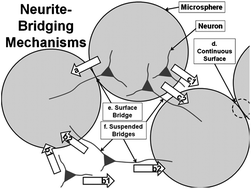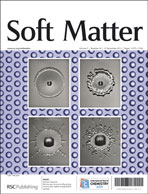Mechanisms and promotion of 3D neurite bridging between PHBV microspheres in a microsphere–hydrogel hybrid scaffold†
Abstract
Poly(3-hydroxybutyrate-co-3-hydroxyvalerate) microspheres have been previously found to support the proliferation and differentiation of a variety of neuronal cells; however, to establish functional neural networks and tissue integration, the cells on the microspheres have to be connected. It was found that neurites bridged the microspheres but these connections were fragile. Thus, the neurons on PHBV microspheres (neuron–microspheres) were encapsulated in a laminin–collagen hydrogel to promote and protect the bridging formations. Bridges were found across the continuous surface between microspheres in contact (surface bridges), and in the gel space between microspheres (suspended bridges). This neuron–microsphere–hydrogel construct increased the proportion of bridge-forming neurites by 31% as compared to neuron–microspheres alone. Furthermore, the neuron–microsphere–hydrogel was found to increase the proportion of suspended bridges by 3.5 times. The surface bridges were subsequently verified to form from neurites extending across continuous surfaces, and thus packing microspheres closer to generate more continuous surfaces increased surface bridging by 70%. However, seeding cells into the gel space did not increase the proportion of suspended bridges but this still increased the overall proportion of bridges by 21%. Images of neurites in the gel space suggested that suspended bridges could have formed instead from neurites extending out of microsphere surfaces into the gel space. This is the first study to focus on neurite bridging and microspheres as scaffolds supported by hydrogel. Furthermore, a novel neurite guidance cue was found in the form of continuous surfaces.


 Please wait while we load your content...
Please wait while we load your content...